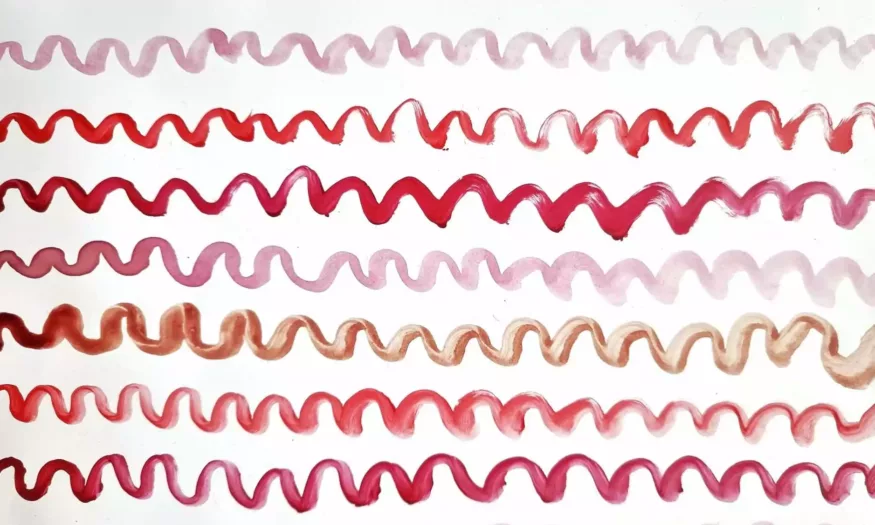Premenstrual Dysphoric Disorder (PMDD)
 “PDD – Premenstrual Dysphoric Disorder acronym with marker, concept background” by Jernej Furman CC BY 2.0: https://creativecommons.org/licenses/by/2.0/
“PDD – Premenstrual Dysphoric Disorder acronym with marker, concept background” by Jernej Furman CC BY 2.0: https://creativecommons.org/licenses/by/2.0/
-
Topics Include:
Diet
Menstruation (Periods)
Mental Health
Premenstrual Syndrome (PMS)
The following text uses the word “pussy*” as defined by Pussypedia.
by Ashley Biggs
What is going on?
Premenstrual dysphoric disorder (PMDD), not to be confused with premenstrual syndrome (PMS), is a severe mood disorder that affects millions worldwide. Those who suffer from it may have both physical and mental symptoms in the weeks before they start their periods.1
For many, thoughts of the possibility of having PMDD arises when they notice extreme PMS symptoms and sometimes unbearable feelings of anger or irritability that aren’t always there. For those affected, PMDD can feel like multiple personalities, or like living with an inner monster and waiting for it to strike every month. Once menstruation starts, the symptoms begin to subside quickly, giving a brief respite. Unfortunately this period of relief can be clouded by the thought of knowing the difficult time will return. Due to the lack of effective, long-term treatment, some people with extreme cases have even gone through with having a full hysterectomy.2 This lack of effective treatment options can cause the diagnosis to feel like more of a burden than an answer. Fortunately, more research is being done.
Symptoms
Mood symptoms play a key role in diagnosing PMDD. The DSM-5 — the official book on mental health disorder diagnosing — has several criteria that a patient must experience to be considered to have PMDD.3 The symptoms occur during the last week of the luteal phase (the two weeks before menstruation) but there is a relief in symptoms after the first few days of menstruation, and symptoms are minimal or absent in the week after menstruation.3,1
At least 5 of the symptoms listed below and at least one of the first 4 must be present:4
- Marked affective lability (feeling suddenly sad or tearful, or experiencing increased sensitivity to rejection)
- Marked irritability or anger or increased interpersonal conflicts
- Marked depressed mood, feelings of hopelessness, or self-deprecating thoughts
- Marked anxiety, tension, and/or feelings of being “keyed up” or “on edge”
- Decreased interest in usual activities (e.g., work, school, friends, and hobbies)
- Difficulty concentrating
- Lethargy, extreme fatigue, lack of energy
- Big change in appetite, overeating, or specific food cravings
- Insomnia or hypersomnia
- A personal sense of being overwhelmed or out of control
- Physical symptoms such as breast tenderness or swelling, joint and/or muscle pain, weight gain or a sensation of bloating
Symptoms must:
- cause distress or interference with work, school, usual social activities, or relationships with others (e.g., avoidance of social activities; decreased productivity and efficiency at work, school, or home).
- Have been met for most menstrual cycles within the past year, and should be confirmed through daily tracking for at least 2 menstrual cycles.
- Not be the symptoms of another disorder (although it’s possible to have multiple disorders).
- Not be the result of a substance (like drugs or medications) or another medical condition.
Causes
The exact cause of PMDD is unknown and actively being investigated. Causes may include sensitivity to reproductive hormones (the ones that change throughout the menstrual cycle), genetics, and social/behavioral factors like stress. The timing of PMDD symptoms correspond to the hormonal changes of the menstrual cycle, but people with PMDD do not appear to have different hormone levels than people without PMDD.1
Recent research suggests that people with PMDD may instead be extra sensitive to normal fluctuations of hormones, especially estrogen and progesterone.1 Research has shown that estrogen plays a big role in mood and behaviors by affecting the function of neurotransmitters like serotonin and dopamine. People with PMDD may not have enough serotonin because of the way their body reacts to menstrual hormonal changes.5
How common is this?
Estimates of how many reproductive age people with pussies* have PMDD range from 2% – 8%.6,7 On one hand, some scientists consider these numbers to be over-reported because of failure to apply strict diagnosis criteria.7 On the other hand, studies have shown that 13-18% of people at reproductive age may experience severe PMDD symptoms, but may not meet the number of symptoms included in the list above.6 This raises the question of how Medicine and the world should think about and treat those who suffer from severe symptoms, but fail to meet the DSM-5 requirement.
How can I take care of myself?
If you suspect you have PMDD, make an appointment with a mental health specialist, preferably a psychiatrist, who treats PMDD.
- Keeping a daily journal of your symptoms and noting how they change with the progression of your menstrual cycle will be very helpful when you see a specialist.
- The most common treatment is an SSRI1 (selective serotonin reuptake inhibitor AKA a type of antidepressant) like Prozac, Sarafem, or Zoloft. Some people take SSRIs continuously, whereas others take them only at the onset of symptoms, stopping once menstruation begins (called “symptom onset therapy”). This method may be particularly useful for treating irritability, mood swings, and affect lability. It does not have as strong of an effect on symptoms of depression, which usually require a longer duration of SSRI treatment.1
- Hormone therapy (oral contraceptives, birth control) is another common treatment method.8
- Cognitive behavioral therapy can help with symptoms of PMDD, although it may not give you an added benefit if you already take an SSRI.1
- Additional treatments include lifestyle changes and general health things like: change in diet, including a decrease in sugar, alcohol, salt, and and caffeine and an increase in protein and healthy carbs; exercise (even just a brisk walk to clear your head and get the blood flowing!); managing stress; and vitamin supplements.4,8 (Keep in mind that these have not been well-studied for their effect on PMDD.4)
More research needs to be done in order to find an effective treatment method for those who suffer from PMDD. At this time, the cause of PMDD is unclear and therefore treatment options are limited and not always effective. It is important that the impact of this disorder be taken seriously to improve the quality of life of those affected.
Author Dedication: My article is dedicated to my best friend and aunt, Sharon, who as a diehard advocate for people with pussies*. She’s a published novelist, an enthusiastic supporter of Planned Parenthood, and my biggest inspiration.
Sources
- “Liisa Hantsoo, C. Neill Epperson. “Premenstrual Dysphoric Disorder: Epidemiology and Treatment.” Current Psychiatry Reports. 17: 87. (2015): <https://link.springer.com/article/10.1007%2Fs11920-015-0628-3>. *This article is sponsored by a National Institute of Health grant but C. Neill Epperson, MD is also heavily invested in the pharmaceutical industry with personal investments in Pfizer, Johnson & Johnson, Merck, Abbott and Abbvie. Lots of current research about PMDD cites her work and we could not get around using her findings. Her conflicts of interest could definitely compromise the integrity of this information. Currently, PMDD is treated with SSRIs which are produced by the companies that Dr. Epperson is invested in. While other studies without conflicts of interest have shown that SSRIs are effective treatment for PMDD, it leaves us a bit 🧐.
- “Ewens, Hannah. “Living with PMS That Makes You Want to Die.” Broadly, VICE, 10 Sept. 2015. <https://broadly.vice.com/en_us/article/wjeeam/living-with-pms-that-makes-you-want-to-die>.
- The American Psychiatric Association. Diagnostic and statistical manual of mental disorders, Fifth Edition, Text Revision. Washington, DC: American Psychiatric Association; 2013.
- “What Is Premenstrual Dysphoric Disorder (PMDD)?” John Hopkins Medicine, The Johns Hopkins University, The Johns Hopkins Hospital, and The Johns Hopkins Health System Corporation. Accessed 2019: <www.hopkinsmedicine.org/healthlibrary/conditions/gynecological_health/premenstrual_dysphoric_disorder_pmdd_85,P00580>.
- Wharton W, Gleason C E, Olson S R M S, Carlsson C M, Asthana S. “Neurobiological Underpinnings of the Estrogen – Mood Relationship.” Current Psychiatry Review. 8(3). (2012): 247–256. <https://www.ncbi.nlm.nih.gov/pmc/articles/PMC3753111/>.
- Halbreich U1, Borenstein J, Pearlstein T, Kahn LS. “The prevalence, impairment, impact, and burden of premenstrual dysphoric disorder (PMS/PMDD).” Psychoneuroendocrinology. 3. (2003): 1-23. <https://www.ncbi.nlm.nih.gov/pubmed/12892987>.
- Yonkers, Kimberly A. MD, Caser, Robert F. “Epidemiology and pathogenesis of premenstrual syndrome and premenstrual dysphoric disorder.” UptoDate. (2019): <https://www.uptodate.com/contents/epidemiology-and-pathogenesis-of-premenstrual-syndrome-and-premenstrual-dysphoric-disorder>.
- “Harvard Health Publishing. “Treating Premenstrual Dysphoric Disorder.” Harvard Health Blog. (2009): <www.health.harvard.edu/womens-health/treating-premenstrual-dysphoric-disorder>.
This article was previously published in Pussypedia and is reposted with permission.






